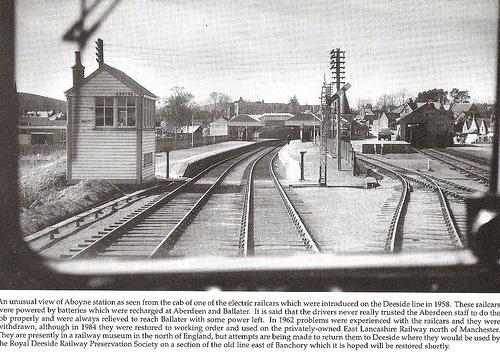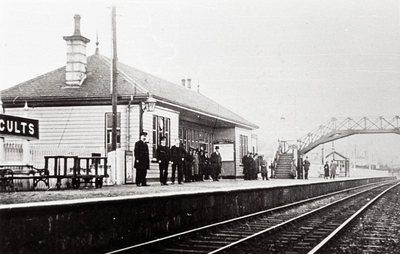Deeside Railway
The Story of the Royal Deeside Railway dates back to 1845, when the Prospectus for the “Deeside Railway” was issued. This was to be a single-line Railway from Aberdeen to the Town of Banchory, following the North side of the Dee River throughout. The Scheme was so well received that it was decided to extend the Line from Banchory through Kincardine O’Neill to Aboyne, just over 29-miles from Aberdeen. Authorised on 16th July 1846, the Deeside Railway was delayed by the Construction of the Aberdeen Railway from Forfar & the Scheme was re-authorised on 28th May 1852, although the Aboyne extension was Postponed to a later date. The Deeside Railway opened to Traffic on 8th September 1853. Eventually the Line was extended to Aboyne (via Torphins, not Kincardine O’Neill) in 1857 and reached Ballater on 17th October 1866. Amalgamated with the Great North of Scotland Railway by 1876 (the latter had Leased the Line since 1862), the Deeside Railway was one of the Region’s most Scenic Railway Lines & for many years was travelled by Members of the Royal Family en route to Balmoral Castle. Indeed, Queen Victoria’s desire for Privacy at Balmoral Castle was the reason why the Deeside Railway never continued as Planned to Braemar at the top of the Dee Valley. Although the Deeside Railway was one of the most Scenic & Picturesque Lines in the Aberdeenshire area, the Line was mentioned in the Beeching Report of 1963 as a Loss-making Railway, closing to Passengers on 28th February 1966. Goods Traffic to the Culter Paper Mills kept the Line open for Freight until 30th December 1966.

Originally the Line from Aberdeen to Banchory (which Opened in 1854) was a Single Track with Passing Loops but between 1884 & 1899 a Double Track was Laid enabling a frequent Suburban Service between Aberdeen & Culter. In 1894 the Deeside Suburban Railway Line was opened, calling at Holburn Street, Ruthrieston, Pitfodels, Cults, West Cults, Beildside, Murtle, Milltimber & Culter. The Deeside Suburban Line was immediately popular, taking 20-mins to Travel the 7.375-miles.
This Photo claims it is Aberdeen Station but the 4 Line Section is not related to either Holburn or Joint Stations readily but appears to be Lined by the Public both on the Tracks & on the Right Platform.
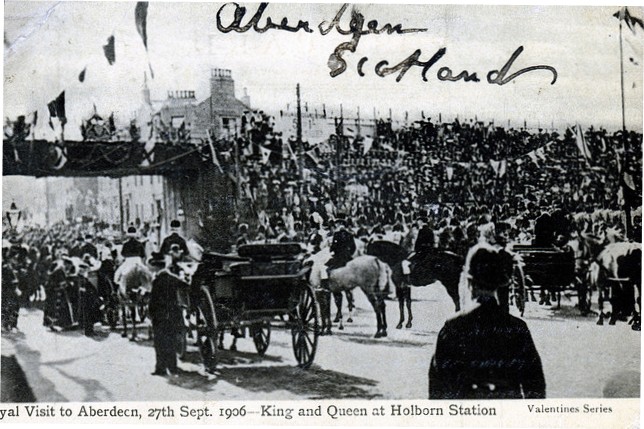
The original Service of 8-Trains doubled in 1900. Holburn Street was renovated in 1906 for King Edward VII‘s Opening of Marischal College. His Royal Train ran from Ballater to the Decorated Holburn Street Station from where Edward went in Procession to Marischal College.
In 1928 the Suburban Railway began to operate Sunday Services to Culter from 1928 to 1936. On 28th January 1937, it was announced that after April 1937 the Suburban Service was to end. Holburn Street was one of the 14 Stations closed as a result of rivalry from Bus Sservices and the waning popularity of the Train Service. This marked the end of a Chapter in Transportation History for Aberdeen. Portions of the Route have been Surfaced for Cycle & Walking Routes. Some Platforms survive.

Holburn Street Station: On the East side of Holburn Street near Grays Road. The original Railway Bridge was Demolished in the 1980s. Holburn Street Station was Closed to Passengers in April 1937 with the ending of the Suburban Services & the Line itself Closed in 1968.
Ruthrieston Station: Opened in 1856, the Station at Ruthrieston followed the Standard style of many Stations introduced at that time, only this one was relatively small & the facilities basic. The Station was constructed of Wood with a Hipped Roof, on the opposite Platform was a simple Waiting Shelter & a Wooden Footbridge linked the 2-Platforms.
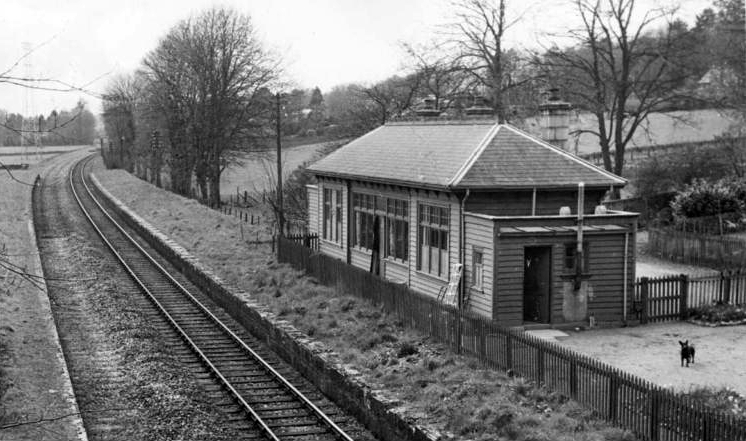
Pitfodels Station: Opened in 1894 & Constructed of Wood the Roof was ”Hipped” or ”Piended”. The Building consisted of a Booking Office, General Waiting Hall, Staff Accommodation & Toilets. On the Opposite Platform was a simple Waiting Shelter. Pitfodels Station was downgraded to a Halt in 1927 because Passenger numbers were insufficient to justify the retention of full Facilities. Suburban Stations & Halts could only give Passengers Tickets to Stations served by the Suburban Train Service, Closed 5th April 1937, the Platform & Main Station survive intact
Cults Railway Station was the 1st Main Station on the Deeside Line between Aberdeen & Ballater. The Line between Aberdeen & Banchory was Opened in 1853 & extended to Aboyne & later to Ballater by 1866. The Double Line, as seen here, was Opened in 1884 & returned to Single Line in 1951.
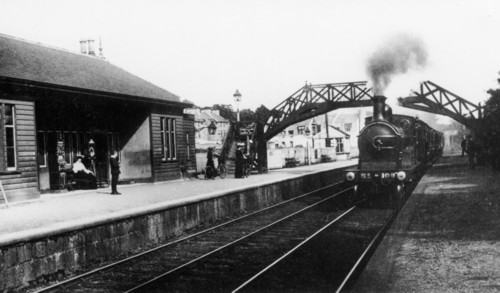
Cults Railway Station – followed the standard style of many Stations introduced at that time, constructed of Wood with a Hipped Roof. The Building on the Aberdeen bound Platform consisted of a Booking Office, General Waiting Hall, Staff Accommodation & Toilets. The construction of a 2nd Platform was completed in 1880 but The Board of Trade said a Shelter must be provided. The Deeside Railway Board’s Minutes from the 24th July 1884 show that the cost of constructing the Verandah (the Official name for the Waiting Shelter) was £106-15s-0d. A Wooden Footbridge connected the 2-Platforms (cost not to exceed £150) was replaced in the 1930‘s by a Metal one when the Wood had rotted. Originally the Deeside Railway had been Authorised to Construct their Line on 16th July 1846. The Scheme was re-Authorised on 28th May 1852. At 1st the Deeside Railway used the Terminus at Ferryhill but when Aberdeen Railway opened their Extension in to Guild Street Station in 1854, the Deeside Line went with them & used that Station. The Deeside Railway that had opened in 1853 Amalgamated with the Great North of Scotland Railway by 1876 (the latter had Leased the Line since 1862). In 1923 the Great North of Scotland Railway became absorbed into the Northern Scottish Area of London & North Eastern Railway. On 28th January 1937, it was announced that after April 1937 the Suburban Service was to end. However, Cults Station continued to be used for the Aberdeen to Ballater Railway Service. The Building which survives dates from the early-1890s, altered to fit its present Industrial role. Cults was the 1st Main Station on the Deeside Line between Aberdeen & Ballater, at 3.6-miles from Aberdeen. The Line between Aberdeen & Banchory was Opened in 1853 & extended to Aboyne & later to Ballater by 1866. The Double Line, as seen here, was opened in 1884 & returned to Single Line in 1951. This view, from about 1920, shows the Stationmaster, Peter Walker, his Staff and a number of Passengers awaiting the imminent arrival of a Train. In 1894, Suburban Trains, “Subbies“, were introduced between Aberdeen & Culter, calling at 8 Intermediate Stations & covering the 7-miles in just over 20-mins. This meant that up to 30-Trains would be calling at Cults every day. The “Subbies” Ceased on 5th April 1937 because of competition from Buses. The Deeside Line closed to Passenger Traffic on 28th February 1966, after the Beeching Report of 1963. Goods Traffic continued for a few more months but the Final Train ran on the Line on 30th December 1966. Cults Station is now occupied by a Joinery Company.
Drawn up at the Platform, the auld Subbie Train
Took folk tae the Toon, then took them back hame
Train wis ey crowded, usually weel filled
Ey the stragglers did rin doon the Hill
Time bein’ up, Guards whussle did blaw
Wi’ a wave of his Flag he wad say “we’re Awa”.
Trains in the mornin’ takin Folk tae the Mill
Trains for up Country did clim up the Hill
Then there’s the Swifty, I min’ it fine
It flashed throu’ the Station for the Toon afore nine
Trains afore breakfast, throu Day, & by Nicht
Iron Horse, noo a memory, wis a gran’ sicht
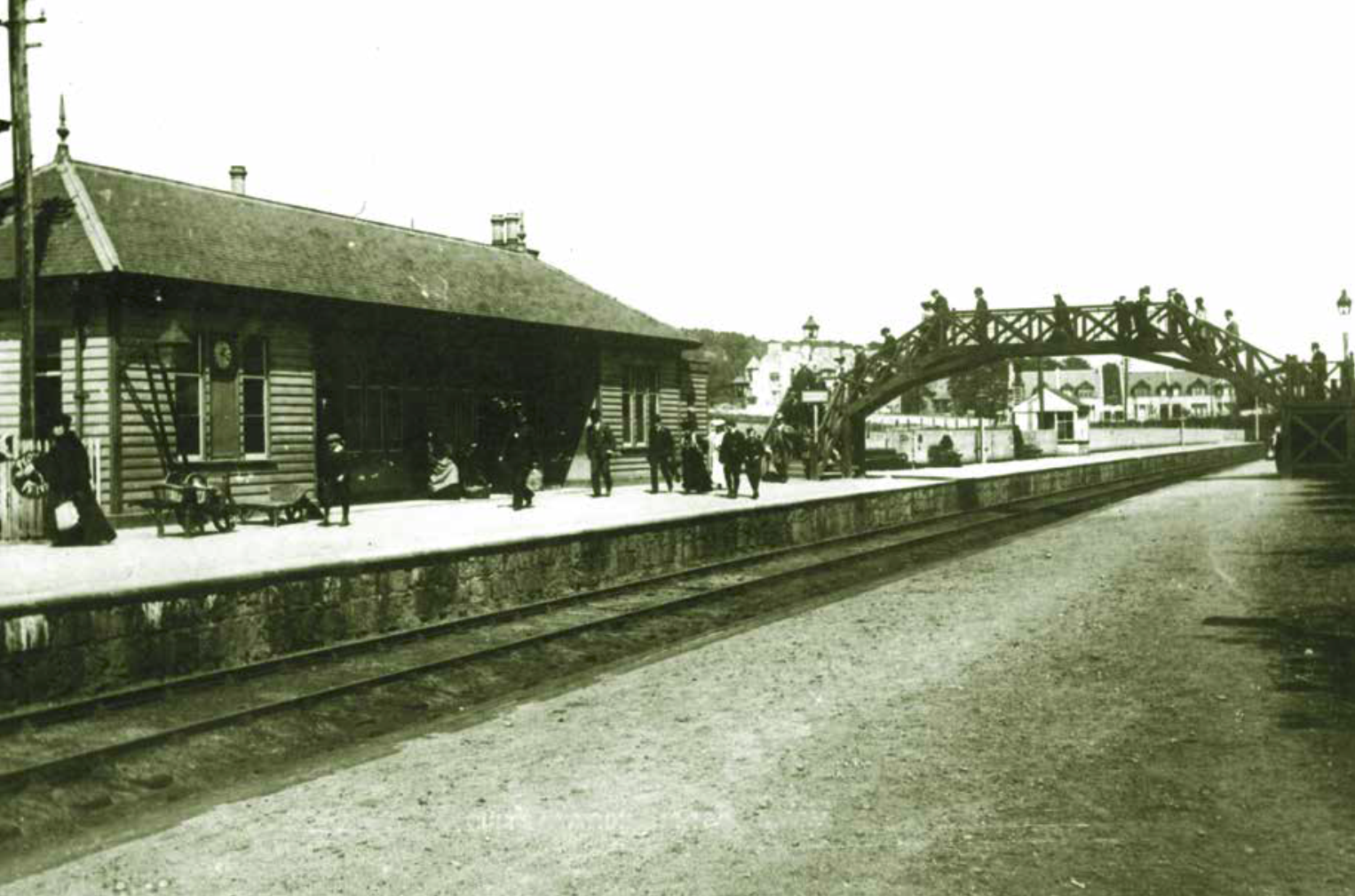
West Cults Station: The Deeside Railway Board’s Minutes record that on the 11th January 1893 it was agreed to provide a Station at West Cults at a cost of £1777. The Station Opened 1st August 1894, the Building followed the Standard style of many Stations introduced at that time, Constructed of Wood with a Hipped Roof. The 2-Platforms were connected by a Wooden Footbridge, which was replaced by the 1930‘s by a Metal one. Deeside Suburban Railway line calling at Holburn Street, Ruthrieston, Pitfodels, Cults, West Cults, Bieldside, Murtle, Milltimber & Culter.
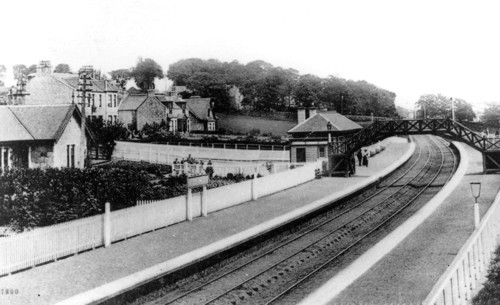
Bieldside Railway Station: The Station at Bieldside was Opened in 1897 & followed the standard style of many Stations, only this one was relatively small in scale. The Station was constructed of Wood & had a Roof that in Architectural terms was called ”Hipped” or ”Piended”. The Building consisted of a Booking Office, General Waiting Hall, Staff Accommodation & Toilets. On the opposite Platform was a simple Waiting Shelter & a Wooden Footbridge linked the 2-Platforms. The Deeside Railway Board‘s Minutes record that on the 11th January 1893 it was agreed to provide the Station at a cost of £1363. The Suburban Deeside Line Opened in 1894 but it was not until 1897 that Bieldside Station Opened. Lower Deeside had to wait for a Local Residential Service while the Double Track from Aberdeen was Built as far as Culter in 1892. The coming of the Service encouraged well-off Aberdonians to have Houses on the Deeside Valley & Bieldside grew as a result of the Station there. In 1928 the Suburban Railway began to operate Sunday Services to Culter, with 9-Trains in the Summer & 8 in the Winter. The Culter Service was then increased to ½-hourly Services for the following 2-yrs. The Sunday Service finally Ceased running in 1936. Nothing is now visible of the Railway Buildings at Bieldside Station, but the Platform, its sides faced with Granite topped by an overhanging Concrete edge, survives with only minor damage.
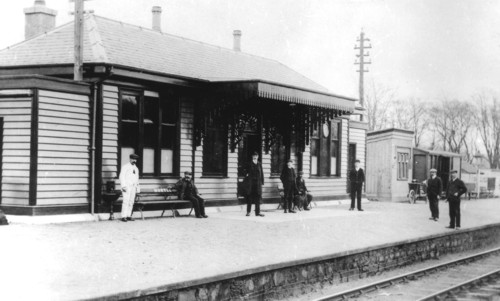
Murtle Station: The original Station at Murtle Opened in 1853 with a Signal Platform & in 1888 a 2nd Platform & Passing Loop was provided. The Station at Murtle was Destroyed by Fire in 1909 & the replacement Station followed the standard Design being used at other Stations. The Station was constructed of Wood & again had a Roof that in Architectural terms was called ”Hipped” or ”Piended”. Awnings were added over the Door to the Platform. Passenger numbers were insufficient to justify the retention of Full Facilities. On the 28th January 1937, it was announced that after April 1937 the Suburban Service was to end. The Building still exists as a Private Dwelling.
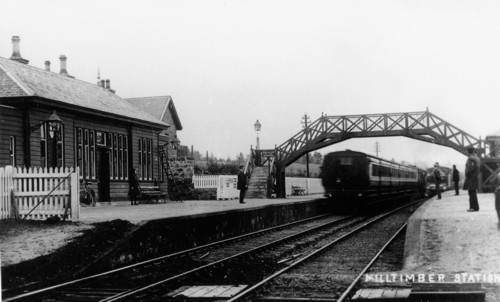
Milltimber Station: The Station at Milltimber followed the standard style of many Stations introduced at that time, only this one was relatively small in scale & the facilities Basic. The Station was constructed of Wood with a Hipped Roof, on the opposite Platform was a simple Waiting Shelter & a Wooden Footbridge linked the 2-Platforms. Lower Deeside had to wait for a Local Residential Service while the Double Track from Aberdeen was built as far as Culter in 1892. In 1928 the Suburban Railway began to Operate Sunday Services to Culter, with 9-Trains in the Summer & 8 in the Winter. The Culter Service was then increased to ½-hourly Services for the following 2-yrs. The Sunday Service finally ceased running in 1936. One of the Station Buildings is now a Private House.
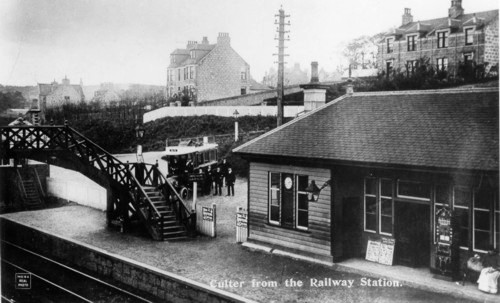
Culter Station – was Opened in 1853 & followed the standard style of many Stations introduced, constructed of Wood with a Hipped Roof. The Building on the Aberdeen Bound Platform, consisted of a Booking Office, General Waiting Hall, Staff Accommodation & Toilets. On the opposite Platform was a simple Waiting Shelter & a Wooden Footbridge linking the 2-Platforms. At Culter, there was a Long Siding running North from an East facing Junction to the Paper Mills. The Line was Double Track from here to Aberdeen but returned to a Single Track before Closure of the Line. Originally Deeside Railway had been Authorised to Construct their Line on 16th July 1846 but this was delayed by the Construction of the Aberdeen Railway Terminus to Ferryhill. The Scheme was re-authorised on 28th May 1852 & Building of the Deeside Extension Railway began. The Line Opened in 1853 from Aberdeen to Banchory, which included Stations at Cults, Murtle, Culter, a Private Platform at Crathes Castle & Banchory. The Deeside Railway Amalgamated with the Great North of Scotland Railway by1876 (the latter had Leased the Line since 1862). The Lower Deeside Residents had to wait for a Double Track from Aberdeen to Culter to be built before Suburban Trains could run as they did at Donside. The Lower Deeside Suburban Service opened in 1892 and was immediately popular, the Original Suburban Service of 8-Trains doubled in 1900. The Deeside Service ran separately from the Suburban Train Service on the Donside & there was a minority of through working. This was mainly due to the cramped conditions of the Joint Station, which Opened in 1867. At that time there was only one Through Platform. In 1923 the Great North of Scotland Railway became absorbed into the Northern Scottish Area of London & North Eastern Railway. On 28th January 1937 it was announced that after April 1937 the Suburban Service was to end. However, Culter Station continued to be used for the Aberdeen to Ballater Railway Service. The Deeside Line was mentioned in the Beeching Report of 1963 as a Loss-making Railway which resulted in its Closure to Passengers on 28th February 1966. Goods Traffic to the Culter Paper Mills kept the Line open for Freight until 30th December 1966, when Class B1 Steam Locomotive No. 61180 became the Last Steam Train to run on the Deeside Railway. Arnott Young Ltd was given the task of dismantling the Line and by 1972 had lifted the Tracks of the Deeside Railway.
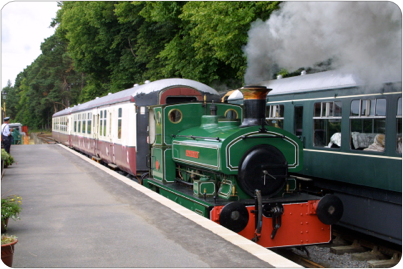
The 0-4-0 Barclay Steam Engine ‘Bon-Accord’. Built in 1897 by Andrew Barclay for the Aberdeen Gas Works, this Steam Locomotive has been the subject of a major 10-yr Restoration Project Other Rolling Stock includes 2–Mk2 Coaches which are used for Service with the Steam Engine & also Serve as the Stationary Railway Tea-room.
The Original Deeside Railway Opened on 8th September 1853 & reached Ballater some 13-yrs later. It amalgamated with the Great North of Scotland Railway in 1876. The Line was regularly Patronised by the Royal Family & other Visitors to Balmoral Castle until it closed in 1966 as a result of the notorious Beeching Report. 30-yrs later, the Royal Deeside Railway Preservation Society was formed & the Work of restoring part of the Line Commenced in 2003. They now have about a Mile of Track in Passenger Service & are gradually extending the Line along the Original Trackbed until they reach Banchory, which will give them a Running Line of just over 2-miles.
The Deeside Railway: The Powers of the Act obtained in 1846 expired after 6-yrs. In 1852 a new Act was obtained for a Railway to Banchory, the part from Banchory to Aboyne being Abandoned. The Railway to Banchory was Opened on 7th September 1853. However, on 30th June 1862, an Act was got by which the Deeside Railway was extended to Aboyne & in 1865 another Act was obtained for extending the Railway to Braemar. Queen Victoria did not favour this Extension & by Purchasing Land through which the Railway was to pass she prevented it from being used. In 1866 the Deeside Railway was made over on a Perpetual Lease to the Great North of Scotland Railway Co.
Aboyne & Braemar Railway: This Line was sponsored by the Deeside Railway & Authorised on 5th July 1865; running from Aboyne to Ballater. It opened on 17th October 1866. In 1868 a Col Farquharson agreed to extend it to Bridge of Gairn to carry Timber from his Estate, but after the Railway had been Laid, Queen Victoria bought the Forest, and the Line was removed. The Road using part of the Route is still known as ‘The Track of the Old Line’. The Company was absorbed by the Great North of Scotland Railway on 31st January 1876, under a retrospective Act of 13th July. On 2nd May 1904, a Motor Omnibus Service was introduced between Ballater & Braemar.
